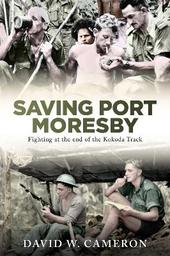
|
Saving Port Moresby: Fighting at the end of the Kokoda Track
Paperback / softback
Main Details
| Title |
Saving Port Moresby: Fighting at the end of the Kokoda Track
|
| Authors and Contributors |
By (author) David W. Cameron
|
| Physical Properties |
| Format:Paperback / softback | | Pages:364 | | Dimensions(mm): Height 5842,Width 3886 |
|
| Category/Genre | History
Military history
Second world war
Transport technology and trades |
|---|
| ISBN/Barcode |
9781922765611
|
|
Publishing Details |
| Publisher |
Big Sky Publishing
|
| Imprint |
Big Sky Publishing
|
| Publication Date |
21 September 2022 |
| Publication Country |
Australia
|
Description
Commemorating the 80th Anniversary of the Battles in New Guinea David W. Cameron one of Australia's leading military historians new Kokoda Campaign series will take you from the Battle for Isurava to Port Morseby and finally the retaking of Kokoda. For the first time, these significant battles of Australian troops are comprehensively explored. After taking Kokoda Plateau in late July 1942, Japanese forces entered the Owen Stanley Range, their mission was to capture Port Moresby. After the battles for Deniki and Isurava, the Japanese pushed south through the mountains. The Australians were in a determined fighting withdrawal. After a delaying action at Templeton's Crossing, they took up a position along Mission Ridge, south of Efogi Village. After two days of bloody hand-to-hand fighting, in a battle known as 'Butcher's Corner', the Australians were again forced to withdraw. After further delaying actions, fewer than 300 Australians took up a position on Ioribaiwa Ridge, just 50-kilometres north of Port Moresby. They were reinforced by the 25th Brigade. After a week of fighting, the Japanese cut through the 25th, forcing the Australians to fall back to Imita Ridge, the last defensible ridge in the Owen Stanleys - immediately behind lay Port Moresby.
Author Biography
David W. Cameron is a Canberra-based author who has written several books on Australian military and convict history, as well as human and primate evolution, including over 60 internationally peer-reviewed papers for various journals and book chapters. He received 1st Class Honours in Prehistoric Archaeology at the University of Sydney and later went on to complete his PhD in palaeoanthropology at the Australian National University. He is a former Australian Research Council (ARC) Post Doctorial Fellow at the Australian National University (School of Archaeology) and an ARC QEII Fellow at the University of Sydney (Department of Anatomy and Histology). He has participated and led several international fieldwork teams in Australia, the Middle East (Turkey, Jordan, Israel, and the United Arab Emirates), Europe (Hungary) and Asia (Japan, Vietnam and India) and has participated in many conferences and museum studies throughout the world.
|